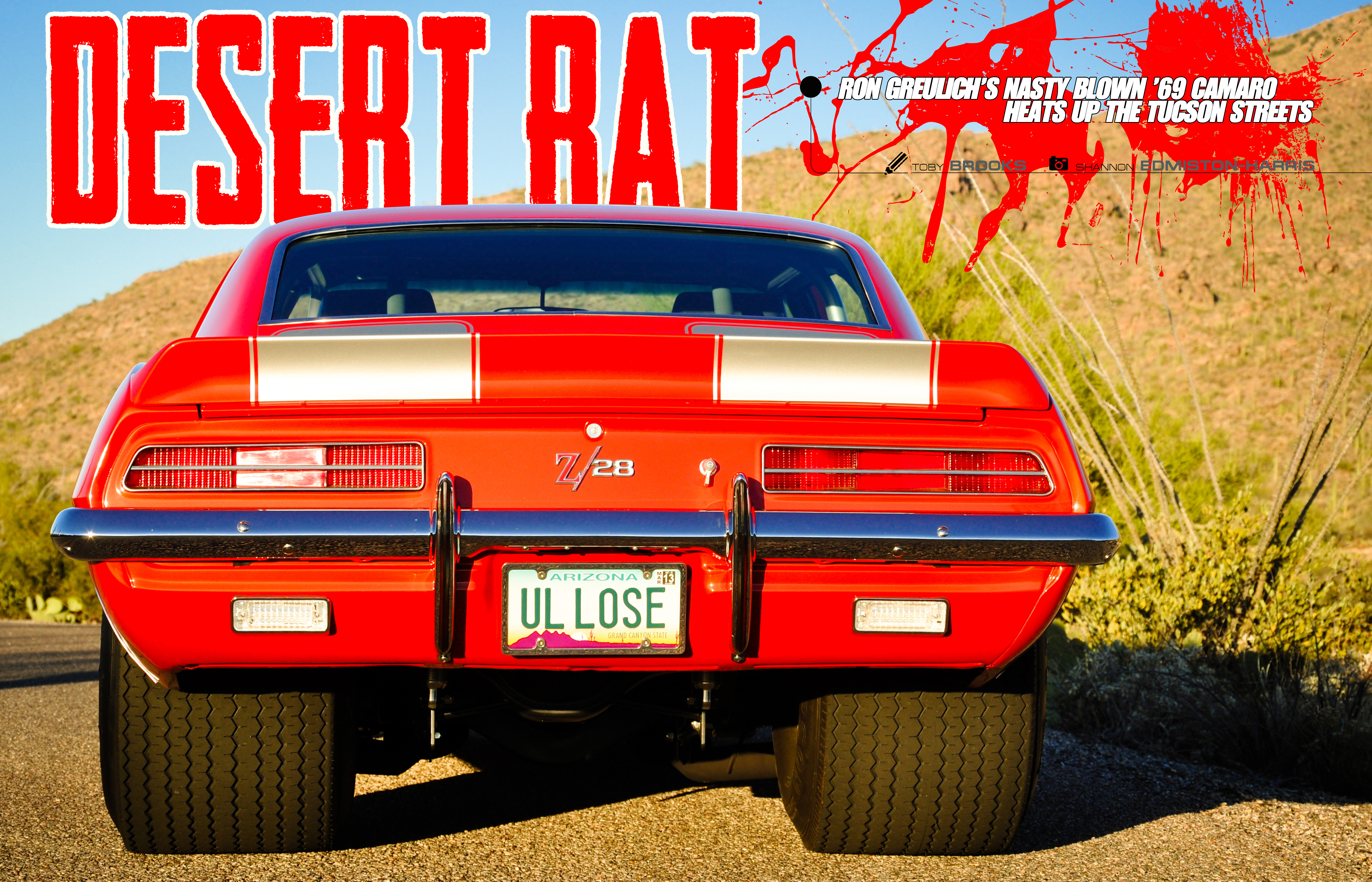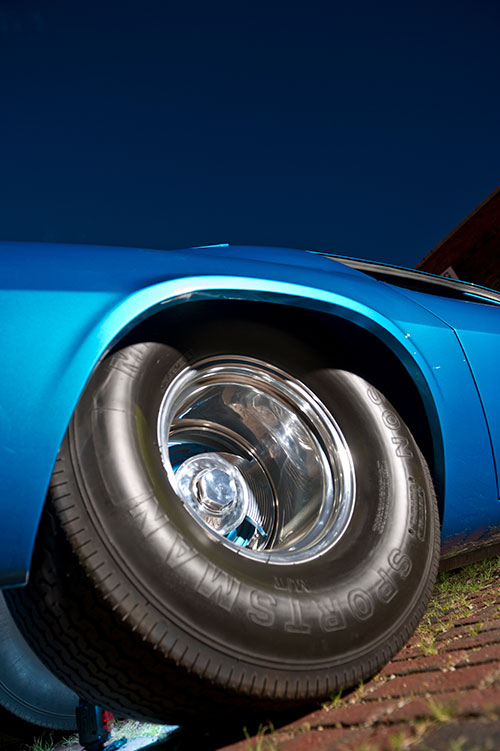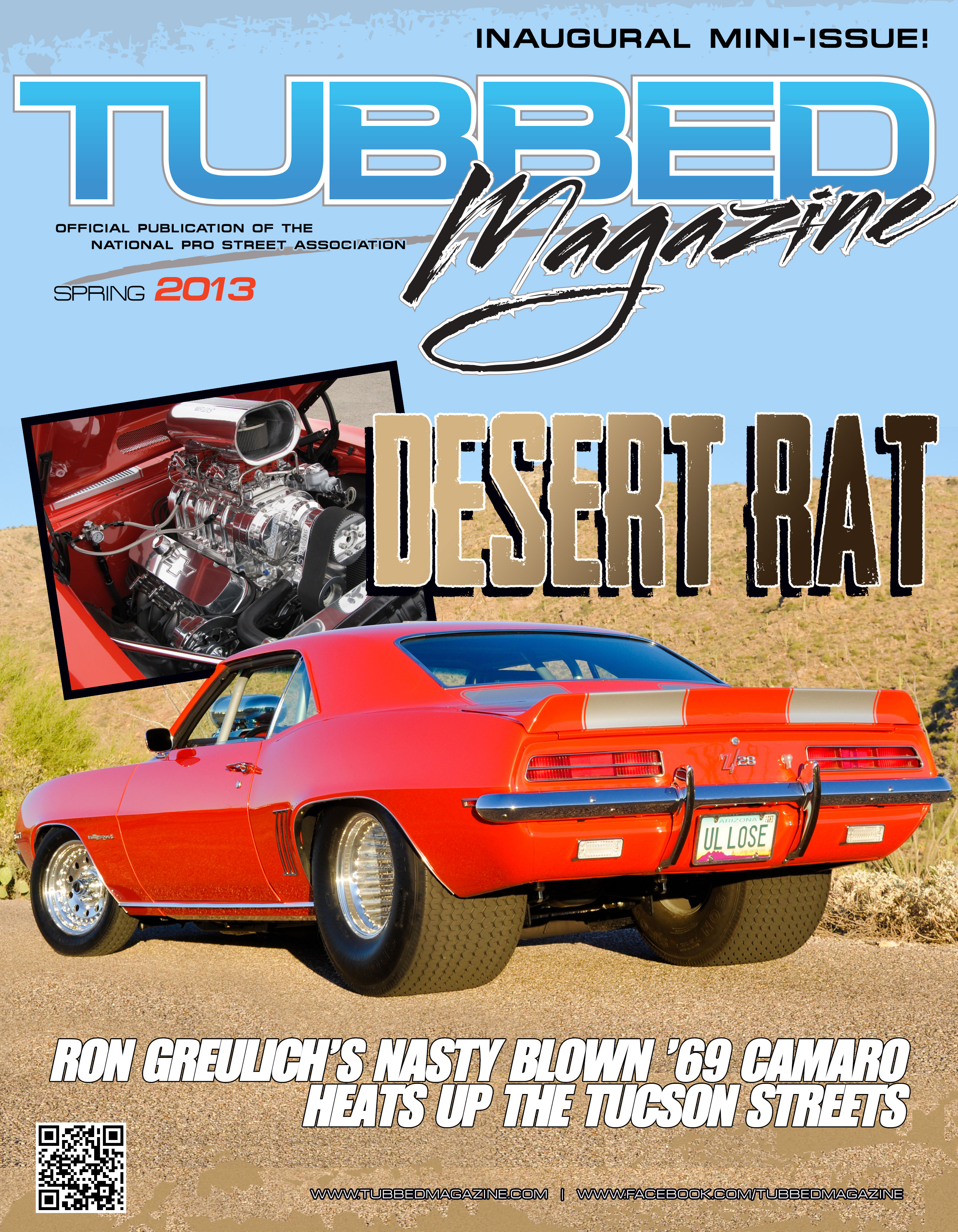Click to see the photo montage video then scroll down to read the feature below!
Life in the desert is hard for most critters. The scorching heat is stifling. The pounding sun and water-parched earth is inhospitable. And the coarse sand and blast-furnace winds are hostile. That’s why an unfamiliar sight like a pristine 1969 pro street Camaro in the heart of Saguaro National Forest country is so stark and startling. And that’s all the more reason to take notice.
A classic and timeless example of all things TUBBED, this RS/Z28 was painstakingly crafted by owner Ron Greulich over the span of three years. Although Greulich might live in pro street-starved Tucson, Arizona now, he attributes his love for street machines to his blue collar Midwest roots.
Born and raised in Monclova, Ohio just outside Toledo, Greulich spent his formative years doing what most of us did—namely kit-bashing model cars while developing his creative eye for 1:1 scale creations. A life-long Camaro lover, Greulich’s first car was a ’76 Type LT that he bought brand new just prior to his senior year in high school.

“The first thing I did was get a set of Cragar SS wheels, some air shocks, and a set of N50 rear tires that hung out an inch or two past the fenderwells,” he recounted. “I added some chrome Hooker three inch sidepipes, too.” Don’t hate. It was the seventies.
Greulich attended his first Street Machine Nationals in 1981. He instantly fell in love with the event, particularly the sea of polished superchargers that seemed to penetrate nearly every hood on the premises.
Through a pair of builds including a 1969 big block Camaro and a pro street 1986 Chevy Silverado, the do-it-yourselfer continued to refine and develop his skills. Greulich always regretted getting rid of his ’69 Camaro in 1984, so when he decided it was time to begin a new build, he knew right away what the target would be. Selling off both his ’76 Camaro and ’86 Silverado to fund the project, he zeroed in on a classic 1969 RS/Z28.
“I found a 1969 Camaro on Craigslist that was a stripped-down former drag car,” he said. “It was already back-halfed, so I figured it would save me some time and money,” he added.
Greulich figured wrong.
The car was passable for strip-only duty, but once Ron really dug in, he discovered that the cage didn’t fit right, the back half wasn’t set up to run the desired 33 x 19.5-inch rear tire, and the body had more plastic than the toy section of a local dollar store. To make things worse, the tin work was substandard and the wheel tubs were too small.
Greulich got right to work, repositioning the rear end two inches, fabbing up a set of home-built 36 inch ladder bars and stretching the back wheel openings 2 ½ inches. The old cage was carefully removed with the “blue wrench” and an Art Morrison 8-point unit was carefully stitched together and coaxed into position.
The rear was beefed up with fortified 9” Ford unit fitted with 4:56 Richmond gears, Moser 31-spline axles, and suspended via QA1 coil overs. A trick set of SSBC disc brakes were selected for stopping duties.
Fresh tinwork was popped in place and a new set of appropriately obese Mickey Thompson Sportsman steamrollers mounted on 15 x 14-inch Centerline Convo ET wheels filled the rear. A set of two-inch drop CPP spindles and QA1 front shocks were installed onto the otherwise stock front suspension before matching 15 x 4 Centerlines and 26 x 7½-inch Sportsmans were mounted in place. The requisite pro street stance was starting to take shape.
With chassis fab work completed, it was time to get the Camaro’s sheetmetal in order. Local body and paint specialist Rick Harris was called into action. Harris replaced the car’s cancer-ridden rear tail panel and painstakingly massaged every other piece of steel until the body was laser straight. A four-inch Harwood cowl induction hood was also installed. A flawless coat of 2010 Camaro Inferno Orange with Switchblade Silver Metallic rallye stripes was sprayed before copious amounts of BASF Diamont clear added miles of perceived depth.
With the paint curing, Greulich turned his attention to motorvation. Ron knew he wanted a big block. And he knew it had to be blown.
“There’s nothing quite like ‘driving a motor vehicle with glass equipment obstructed’,” he said with a grin. Greulich and friend Dan Ackerman had the 454 iron block punched to 468 cubes before popping in a set of 8:1 Speed Pro pistons hung from a factory crank and rods. ARP bolts were selected to hold the entire assembly together. Pro Comp aluminum heads fitted with Scorpion Racing 1.7 roller rockers were torqued into place, but not before a Herbert Hydraulic roller blower cam and roller lifters were carefully coaxed into position.
With the long block complete, it was time for induction. An 8-71 BDS supercharger was topped with a pair of BDS-prepped 750 Holleys. A BDS scoop, Street & Performance aluminum valve covers, and a Milodon seven-quart oil pan were positioned over the engine’s extremities and polished to a consistent sparkle.
An MSD Pro Billet distributor, 6 AL ignition box, and heavy duty plug wires were installed to handle sparking chores, while a Holley HP 890 billet electric fuel pump was plumbed to keep the thirsty beast adequately supplied with petrol. Spent fumes rapidly exit the chassis via a set of 2-inch Hedman headers and a pair of Dynatech split-flow race mufflers.

A fortified TH-400 with a Hughes 10-inch 3,000 RPM stall converter handles the shifting duties. Cooling chores are managed by a Performance Rod & Custom polished aluminum double pass radiator with twin Spal HP electric fans.
Greulich handled all interior duties himself with the exception of custom black carpeting installed by Chris Urbina at Quality Landau & Upholstery in Tucson. The cage was painted to match the car’s stripes before a pair of Scat Procar Elite 1100 seats were bolted into place. RJS 5-way harnesses insure passengers are not ejected during flight and a dashful of Autometer Ultra Lite gauges help the Camaro’s cockpit occupants apprised of all data.
A B&M Magnum Grip shifter assists with gear selection, and a full complement of HushMat throughout the doors and interior helps keep down the racket inside. A pair of Electric-Lite power windows ad a touch of luxury, but the heater, ashtray, and radio delete in the cockpit put any passenger on notice: this ride is way more muscular than some options-loaded, fluffy pro touring wagon.
Now three years and a mountain of heavily zeroed and comma’d receipts later, Greulich finally has his dream car. Unfortunately, the gorgeous example of pro street style often wanders the Tucson streets as an endangered species of sorts.
“There are only a handful of pro street cars in this whole town, and I built three of them,” he lamented.
I wouldn’t worry for long, Ron. Once folks get a glimpse of just how wicked your latest pro street creation looks, they’ll be realizing what we at TUBBED have said all along…
Yeah, it’s still cool.





